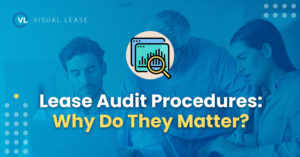
Lease audit procedures are necessary for an efficient, successful audit. At their core, lease audit procedures ensure your organization has controlled processes in place to support its financial reports.
Having such procedures enable auditors to get their job done quickly due to reliable, clearly stated and followed controls. The more organized and prepared you are, the more likely you will avoid running into issues within your audit.
Not only do lease audit procedures better prepare you for an upcoming audit, but lease audit procedures can also provide additional business benefits through supporting optimization of your lease portfolio. Below, we dive into how lease audit procedures can help your business.
6 Lease Audit Assertions
Completeness
Completeness in lease accounting ensures that all leases and lease-related transactions are accurately identified, recorded, and reported in the financial statements. This means that a company must maintain a comprehensive record of every lease agreement, whether for real estate, equipment, or other assets.
Internal controls should ensure that no lease is overlooked and that all relevant transactions, including modifications, renewals, and terminations, are accounted for. This completeness is important for accurate financial reporting and compliance with accounting standards, as any missing lease could lead to misstatements in the company’s financial position.
Existence/Occurrence
The existence and occurrence assertion makes sure that all lease-related assets and liabilities reported in the financial statements genuinely exist and that the transactions have occurred. This is important because companies must provide evidence that it holds the right to use leased assets and has incurred the corresponding obligations.
Internal audit controls should verify that lease contracts are valid and enforceable, and that lease payments have been made or are payable as reported. This ensures that the leases recorded in the financial statements are legitimate and not the result of errors or fraud.
Valuation/Allocation
Valuation and allocation focus on ensuring that lease-related assets and liabilities are accurately valued and correctly allocated in the financial statements. This involves calculating the right-of-use (ROU) asset and lease liability based on the lease’s present value and ensuring that depreciation, amortization, and interest are correctly applied.
Any errors in valuation could distort the company’s financial health. Auditors assess whether these amounts have been calculated using appropriate discount rates and whether any lease incentives, like rent abatements or tenant improvement allowances, have been properly accounted for.
Cut-off
Cut-off refers to the proper timing of lease transaction recording, ensuring that they are reported in the correct accounting period. This is particularly important when leases are modified, terminated, or renewed, as incorrect cut-off dates can lead to inaccuracies in financial statements.
Auditors examine whether transactions are recorded when the lease’s control or obligation transfers to the lessee, aligning the financial statements with the company’s true financial position at the reporting date.
Rights/Obligations
The rights and obligations assertion ensures that the company has both the legal right to use the leased asset and the obligation to make lease payments. This is verified by reviewing lease agreements to confirm that the company has the rights to use the asset and that fulfills the terms of the lease, including making timely payments.
Auditors also check for any clauses in the lease contracts that could impact these rights or obligations, such as options to purchase or renew, which may affect the accounting treatment.
Presentation & Disclosure
Presentation and disclosure ensure that lease information is presented clearly and in accordance with the relevant accounting standards. This includes properly categorizing leases as operating or finance leases and making all required disclosures regarding the terms, amounts, and risks associated with the leases.
Auditors verify that lease-related transactions are presented accurately in the balance sheet, income statement, and cash flow statement, and that detailed footnotes provide transparency regarding lease commitments, future payments, and any contingent liabilities.
These assertions are used by auditors to assess the accuracy and completeness of a company’s lease accounting. By testing these assertions, auditors can help to ensure that the company’s financial statements are accurate and that they comply with applicable accounting standards.
Role of Internal Controls in Lease Audits
When conducting a lease accounting audit, internal controls play a crucial role in providing accurate and reliable financial reporting. Effective internal controls help to mitigate risks, detect errors, and ensure compliance with accounting standards such as ASC 842 or IFRS 16. Companies should establish thorough procedures for tracking lease data, including the identification, valuation, and reporting of lease-related transactions.
Aside from that, controls should be in place to ensure the completeness of lease portfolios, the correct classification of leases, and the regular monitoring of lease modifications. A good internal control system also ensures that lease transactions are recorded in the appropriate accounting period and are accurately reported. By building strong internal audit controls, businesses can prepare for external audits and ensure compliance with lease accounting regulations.
How to Better Prepare for the Audit Process for Lease Accounts
Anticipate Audit Needs
Lease audits focus on providing an independent evaluation of asset control and risk. This evaluation is designed to drive continuous improvement to an organization’s processes and system.
The Journal of Accountancy outlines a number of challenges for auditors when approaching the leases section of the audit. Gaining a broader understanding of these challenges is an excellent first step in preparing for lease audit procedures under ASC 842.
When preparing for an audit, the goal for accounting and finance professionals is to ensure their books are in order for when the auditors come around. A significant component of this preparation is completeness assertion, which translates to ensuring all transactions that were supposed to be recorded have been recognized in the financial statements.
Nearly all (99%) senior finance and accounting professionals have concerns about misreporting company lease information.
Avoid Costly Mistakes
The absence of lease audit procedures can present a challenge when leased asset information is not readily available or in a central database.
To comply with the new lease accounting standards, all lease arrangements and amendments need to be identified, reviewed and abstracted. Financial statements are impacted with lease-related assets, receivables, liabilities and deferred inflows of resources coming on to the statement of net position.
Essentially, preparing for an audit means looking at an organization’s leased asset portfolio and ensuring all relevant stakeholders are assessed and addressed.
New lease accounting standards, like ASC 842, are likely to get more attention than usual from the auditors. Delays or missteps can put your business’ audit at risk of costly mistakes, such as increased audit fees, fines or damage to company and personal reputation. But having everything ready for the auditors puts the liability on them to get their job done accurately and efficiently.
Ensure Accurate Compliance
As mentioned earlier, the key to successfully completing lease audits is being prepared and organized.
The end goal of lease audit procedures is to ultimately eliminate the need to worry by ensuring procedures are identifiable and support compliance under lease accounting standards.
By having a centralized database and lease accounting system in place, finance and accounting professionals will not only be able to get the information they need quickly and easily, they will also subconsciously adopt time-tested lease audit procedures as a science. Check out our lease accounting audit checklist to make sure your company is prepared for their next audit.























